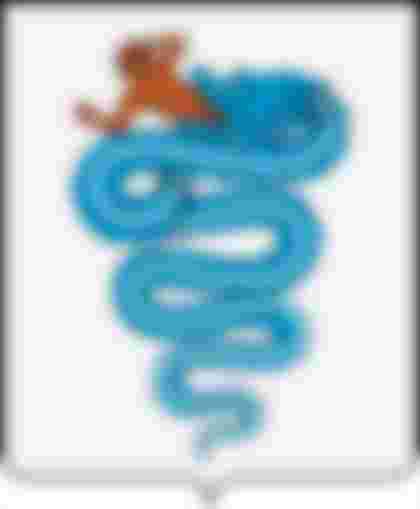All over the world and throughout the whole human history, snakes and serpents have been important symbols and they have played an essential role in many mythologies. In a previous article, we looked at some of the major ones. Let us finish this overview of snake symbolism with astrology and heraldry.
Astrology
What is the Chinese year of the snake? What does the snake mean in Chinese astrology?
The years of the Chinese calendar are named after the 12 animals of the Chinese zodiac: rat, ox, tiger, hare/rabbit, dragon, snake, horse, sheep, monkey, rooster, dog, and pig. One sign for each Chinese Lunar year during a 12-year cycle.
The Chinese snake is considered as intelligent and cunning, interested in material wealth, and a saying states that “a Snake in the house is a good omen”; it means your family will not starve. The snake is said to be acute, aware, proud, vain, vicious, contemplative, and private. It is the most introspective of the zodiacal signs.
There is no apparent snake in Western astrology, but there ought to be one. The fact is that the ecliptic doesn't only pass through the well-known 12 Zodiacal signs, it also passes through a constellation named Ophiuchus, “the Serpent Holder” or “the Serpent Bearer”, which, strictly spoken, ought to be a 13th sign of the general Zodiac.
In mythology, Ophiuchus has been identified with a number of figures, such as Apollon, Laocoon, and Asclepius.
Snakes in Heraldry
Heraldry has its own symbology where both serpents and dragons are common. If we refrain from discussing pure dragons - serpents or snakes have a mainly positive connotation. Many books on heraldry assign to snakes the symbolic meaning of wisdom.
They appear on coat of arms in many forms and positions, sometimes two snakes in a knot. The basic positions for a single snake, however, are erect, involved, glissant (gliding horizontally), and nowed (knotted).

Other forms that are sometimes used are the Ouroboros, the Caduceus, and the Rod of Asclepius.
Arthur Charles Fox-Davies, in his A COMPLETE GUIDE TO HERALDRY [London & Edinburgh 1909] wrote:
"The usual heraldic Serpent is most frequently found ''nowed," that is, interlaced in a knot. There is a certain well-understood form for the interlacing which is always officially adhered to, but of late there has manifested itself amongst heraldic artists a desire to break loose to a certain extent from the stereotyped form. A serpent will sometimes be found ''erect" and occasionally gliding or “glissant," and sometimes it will be met with in a circle with its tail in its mouth the ancient symbol of eternity. Its constant appearance in British armoury is due to the fact that it is symbolically accepted as the sign of medicine, and many grants of arms made to doctors and physicians introduce in some way either the serpent or the rod of Asculapius, or a serpent entwined round a staff. A serpent embowed biting its tail occurs in the arms of Falconer, and a serpent on its back in the crest of Backhouse. Save for the matter of position, the serpent of British armoury is always drawn in a very naturalistic manner. It is otherwise, however, in Continental armoury, where the serpent takes up a position closely allied to that of our dragon. It is even sometimes found winged, and the arms of the family of Visconti, which subsequently came into use as the arms of the Duchy of Milan, have familiarised us as far as Continental armoury is concerned with a form of serpent which is very different from the real animal or from our own heraldic variety."
The Biscione
The serpent of the coat of arms of the family Visconti is called the Biscione or Vipereos mores non violabo. Heraldically the coat of arms is described as
"D'argento alla biscia ondeggiante in palo d'azzurro ingolante un moro di carnagione."

The description of the human varies; mostly it is a Moor, sometimes a child. The stories behind this symbol are many and the truth about why it came to be associated with the House of Visconti is not known.
Some sources say that the picture has to do with the story about Jonah and Leviathan, but it is unclear how that would apply to the family Visconti. A more plausible explanation suggests that the Biscione is of Middle Eastern origin; that, during one of the Crusades, Ottone Visconti (1207–1295) took it from the coat of arms of a Saracen he killed. However, I have not been able to find this design in any Middle Eastern sources.
Related article:
From the Sacred Cobras of Egypt to Quezalcoatl: Serpents & Snakes in Mythology
(This article is based on material previously published in Meriondho Leo, and in my e-book “Serpents & Snakes”, 2019.)
Read the whole series:
1. From the Sacred Cobras of Egypt to Quezalcoatl: Serpents & Snakes in Mythology
2. Snakes in Astrology & Heraldry

Copyright © 2013, 2019, 2021 Meleonymica/Mictorrani. All Rights Reserved.
All my articles about history can be found here, about serpents & snakes here, and about symbols here.
You find all my writings on Read.Cash, sorted by topic, here.
If you are interested in history, join my community History, Myths, Legends & Mysteries (be45).



Nice article ... 👍